Blog Archives
September 13, 2003 
Gurudeva on the Caribbean innersearch...
Our Beloved and Revered Satguru Sivaya Subramuniyaswami
Attained Maha Samadhi on November 12th, 2001
Click to read for Details.
We are pleased to announce the web release of Satguru Sivaya Subramuniyaswami's monumental work on Hindu culture and lifestyle:
Living with Siva.
Click here for the entire text and artwork, now on-line!
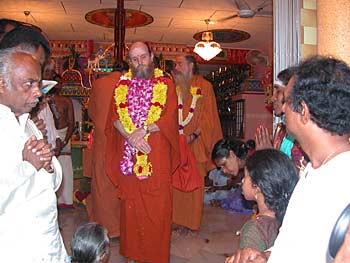
We continue with our story of the Bodhinatha's mission. Today we have picture of the last day at the Ulu Behrang Ganesha temple Kumbhabhishekam... Bodhinatha here awaits the move to the top of the temple to pour water over the spires on high...
Bodhinatha's Sun One Video. Most Recent update: September 12, 2003. Bodhinatha speaks on Ahimsa, noninjury, yama #1, which is noninjury in thought, word and deed. The law of karma decrees that it is wise not to harm or hurt others, for we will then receive harm and hurt in exchange in the future. 12 minutes, 29 seconds.
 |
|
|
|
Live Web Cam Pix! |
 |
||||
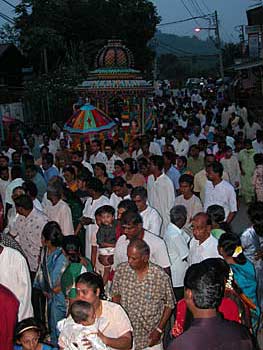
Saravananathaswami writes: "These are photos from September 7, Sunday, in Malaysia. All photos below were taken at the Ulu Behrang Ganesha Temple 12 year kumbhabhishekam. Twelve years ago Gurudeva attended a kumbhabhishekam too, hosted by the Tiru Jothiswarar family. This time Bodhinatha was given the same royal treatment, including an enthusiastic procession in a big chariot through the streets to the temple, led by nagaswaram and tavil.
As the chariot rolled along, devotees scurried to lift telephone wires above the top of the chariot with a bamboo pole! It felt just like being in India.
The camera had a temporary problem, so we didn't get photos of Bodhinatha going up stairs to the top of the vimanam to pour the kumbha water.
Also there were two hydraulic lifts from which Tiru Jothiswarar, his sons Selvanathan and Kanesh and other priests poured blessed water and flowers from high above down to the outstretched hands of the waiting devotees.
Bodhinatha reading a short talk about the blessings of Lord Ganesha.
In the yagnasala for final blessings of the kumbhas before Bodhinatha carried them up to the top of the vimanam.
The kumbhas are passed over by the priests.
One is placed on Bodhinatha's head.
After a short procession, the kumbhas are poured over deities in the temple and taken outside and up to the top of the temple to be poured over the very top of the Vimanam....
Following the ceremonies, we started a 3.5 hour vibhuti darshan, the longest Bodhinatha has ever done.
It is estimated that up to a few thousand people may have received vibhuti during this time.
Little children were brought forward as well.
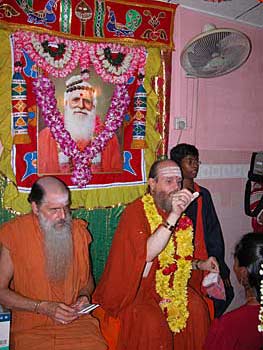
Aum Namasivaya!
The swamis gave out pictures.
After the ceremonies ended, Bodhinatha and the team were off, driving back to Kuala Lumpur and then on to a flight to Singapore. It was an action packed day to be sure!
![]()
Saiva Siddhanta Church
Golden Gate Mission
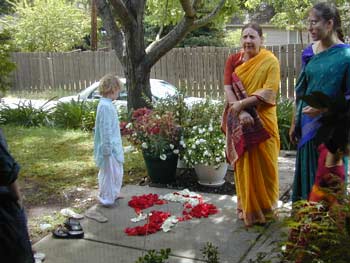
Two of our sishya in the Golden Gate Mission had been married before they became Hindus and recently their union was re-consecrated through a traditional Hindu wedding ceremony held at the Golden Gate Mission in California.
Church members Jeyendra, Asha & Mira waiting around the Ganesha flower kolam made with Rose petals at the mission home of Kulapati Easvan Param.
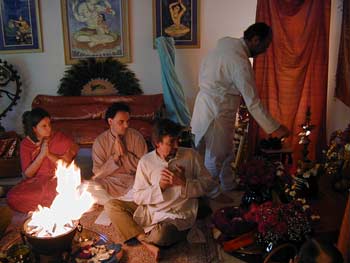
Church members, husband and wife, Sahanadevi & Chandran Param and Adi Alahan look on as Padipalar Vijay Sankara performs arati to Lord Ganesha to begin the Thali Tying Ceremony.
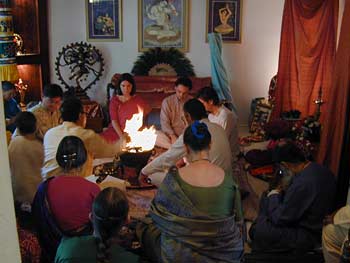
Golden Gate Mission members attend the Thali Tying Homa for Chandran and Sahanadevi. Fire Devas bless the couple.
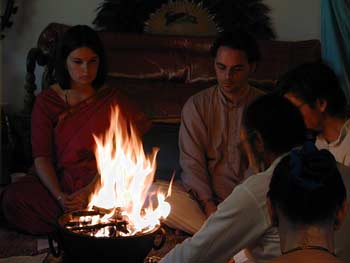
Pechular Adi Alahan reads "What is the Central Purpose of Marriage" from Dancing With Siva, (Sloka 71) while more Fire Devas bless the couple.
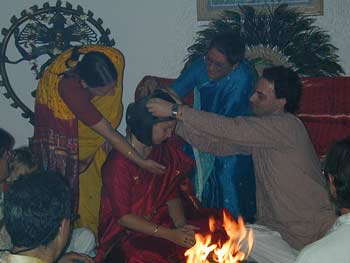
After the Thali has been blessed, it is handed back to Chandran at the end of the Homa, and he carefully ties it (with the help of Aunties Asha Alahan and Valli Sendan, being careful it does not slip while saying:
"May the Gods grant that thy heart may forever dwell within me.".
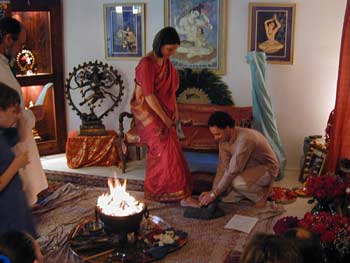
Chandran places the toe rings on Sahanadevi's feet while reciting,
"May you be as steadfast and strong as this stone in our marriage",
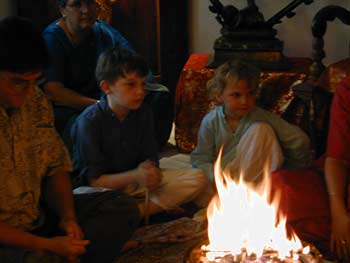
Bhajana and Jeyendra Param look on as their parents perform the Vivaha Samskara.
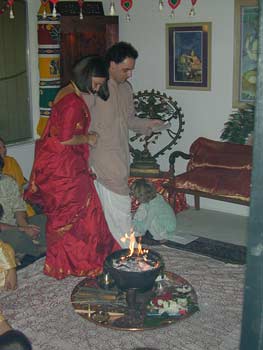
Chandran and Sahanadevi together taking seven steps around the Homa.
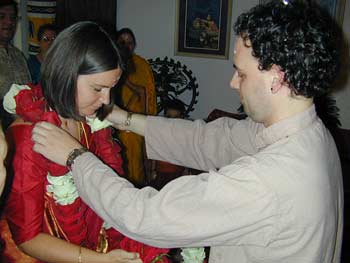
Chandran and Sahana exchange rose garlands

Padipalar Vijay Sankara performs arati to the couple

The happy family united after the ceremony
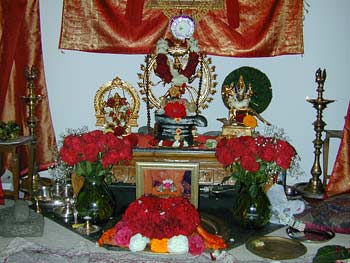
Shrine at Kulapati Easvan Param's home following the Thali Tying Ceremony

Young Chidambaram Sendan watches on with a mouth full of grapes.

Chidambaram Sendan helps himself to a taste of Adi Alahan's Birthday cake
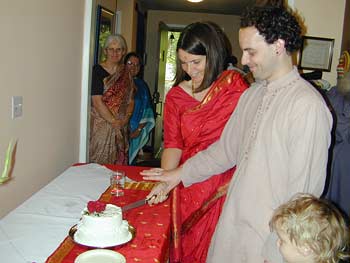
The happy couple cut the wedding cake.

Here at Kauai Aadheenam today a spiritual tour group of 40 souls from a Norwegian Star cruise came for a visit.
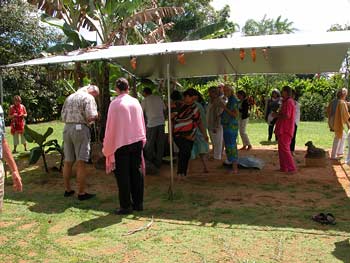
They were very eager to visit the San Marga swayambhu lingam.
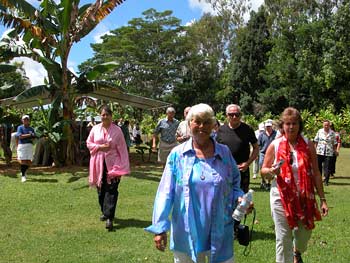
Today's Inspired Talk |
|
|
Title: The Yama of Ahimsa Category: Yamas and Niyamas Duration: 11 minutes, 23 seconds Date Given: September 12, 2003 Date Posted: September_13_2003 Given by: Bodhinatha |
|
For more information about listening to Gurudeva's talks online and to hear them in other formats, click here. And click here for an Index to All Past CyberTalks. Study Gurudeva's teachings
every day. Visit the Master Course site!
Bodhinatha will be happy to hold "Prasnottara Satsang" -- "Questions and Answers" over the telephone with any Hindu religious societies, Hindu youth groups, Radio talk show hosts etc. All you need is a phone with a speaker and an enthusiastic audience. Arrangements may be made in advance by sending email to Sannyasin Saravananathaswami If you are experiencing any problems listening to the audio, please to go our Audio FAQ page and follow the directions there.
| FULL INDEX OF 650+ CYBERTALKS
 |
|
Study Gurudeva's teachings.
|
transcription begins
Date: July_23_2003
Title: The Niyama of Siddhanta Shravana
Category: Yamas and Niyamas
Duration: 11 min., 33 seconds
Date Given: July 08, 2003
Given by: Bodhinatha
Good morning, everyone! Welcome to our five-day Satguru Purnima festival. Happy to have you all here, from off the island. Glad you were able to come. The talk this morning is in two parts. The first part is our regular Yama-Niyama talk. Those of you who watch our TAKA page, have probably seen some of that go on there. Every week, we have been developing one of the yamas or niyamas, the twenty principles of Hinduism's code of conduct and we are developing them for use in classes, particularly in Singapore and in Malyasia. They have some active classes there. So, we are trying to help them by supplying this material, trying to step down Gurudeva's very beautiful elucidation of the Yamas and Niyamas, bringing them down to earth with practical examples and stories and in some cases, ways of overcoming them. Like yamas, we are drawing on some of the different tools from 'Merging with Siva', to restrain those tendencies. In Singapore, the classes are at the Hindu Center there, Sivakumar Saravan has been asked to head their teaching program. So, with our permission, he has. Some of the material he is using is drawing from the Yamas and Niyamas.
In Malaysia we have, what is called, our Core Youth Committee. In Malaysia, youth is anyone up to 30 years old. So, our Core Youth Committee is busy preparing themselves to start regular 'Master Course' seminars.
It is interesting timing that we are on Niyama 6, Scriptural Listening, Siddhanta Sravana. This is the first Niyama, where Gurudeva brings in the Guru. He says that the Guru relates to the last five Niyamas, 6 to 10. So, it is perfect timing that we are introducing this Niyama on Satguru Purnima!
Today's lesson on 'Good Conduct' is on the sixth Niyama of Siddhanta Sravana, which is to eagerly hear the scriptures, study the teachings and listen to the wise of your lineage. Choose a guru, follow his path and don't waste time exploring other ways. Read, study and, above all, listen to readings and dissertations by which wisdom flows from knower to seeker. Avoid secondary texts that preach violence. Revere and study the revealed scriptures, the Vedas and Agamas.
Let's look at some examples illustrating the practice of this Niyama.
First example: A young man had been regularly reading a translation of the Upanishads for a few years. He then had the opportunity to listen to a few lectures by a visiting swami on the philosophy of the Upanishads. He found the lectures gave him a great deal of new understanding he had not been able to acquire just from reading.
Second example: A few lady friends of a woman invite her to go with them to listen to a famous lady saint and have her darshan. She politely declined and explained that she had already chosen her guru and no longer went to see or hear other Hindu religious leaders.
Third example: A newly wed couple was given a copy of the 'Tirukural' as a wedding gift. They started reading it regularly every week and found it gave them lots of very practical advice on how to maintain a cultured Hindu home.
Fourth example: Satguru Yogaswami is quoted as saying to one of his disciples, "It is not in books, you fool." This was because this particular disciple had the false concept that learning through books was the highest attainment. Yogaswami was encouraging him to turn what he had already learned from his reading into personal experience, through performing regular religious disciplines under his direction.
All of the Niyamas focus on expressing the refined soul qualities within each of us. In the case of Siddhanta Sravana, the divine quality we are expressing is becoming a more spiritual person through acquiring scriptural knowledge. It is important to note that this is much more effectively done through listening to the talks of Hindu religious leaders than through the mere reading of books.
Gurudeva shares a deep insight into the nature of Siddhanta Sravana in stating that it is developing through scriptural study an entirely new mind fabric, subconsciously and consciously. He goes on to further explain that Siddhanta Sravana lays the foundation for initiation within the fabric of the nerve system of the disciple.
Here is a story to further illustrate Siddhanta Sravana. A young woman initially found her study of Hinduism to be confusing and contradictory. After learning that Hinduism has four different main denominations and that in many ways they differ and on some points even disagree, her study made much more sense. She then decided it was best to just study the teachings of one of the denominations and as a result has since made good progress in deepening her understanding. Recently she asked a swami to be her guru and is looking forward to qualifying for initiation from him in a year or so.
The 'Tirukural' in its chapter 42, 'Learning by Listening', in verse 413 stresses the importance of learning by listening.
"In Heaven, deities feed from sacrificial fires. On Earth, men who feast on listening are their equal."
To state that the Kural doesn't even have a chapter on learning by reading helps even more in understanding the importance that it gives to learning through listening.
The first step in practicing Siddhanta Sravana is simply to study Hindu scriptures. The Vedas and Agamas are Hinduism's core scriptures. They are called 'sruti', that which is heard. Of these, the Vedas are the primary scripture and the final section of the Vedas is the Upanishads, which contain important truths about spiritual unfoldment and the nature of the soul. An interesting fact is that the Vedas are the world's most ancient scriptures, and that the oldest portions of the Vedas are thought to date back as far as 6,000 BCE.
The Agamas are Hinduism's second authority. Saivism, Saktism and Vaishnavism each have their own Agamas which provide guidelines for their respective forms of sectarian worship, sadhanas and philosophy.
Taking Siddhanta Sravana to its second level is accomplished through going beyond reading sacred scripture, by listening to the talks of Hindu religious leaders. This is important because it is through hearing that the transmission of subtle knowledge occurs from knower to seeker. The reason for this is that when the speaker has a deep understanding of the Hindu teachings based on personal insight and experience, the listener is able to grasp some of that depth through the sound of the speaker's voice. Of course, the deeper the realizations of the speaker, the more knowledge the listener can grasp.
It is also interesting to note that the Vedas are traditionally taught by listening to the teacher rather than by reading a text. In fact, originally the Vedas were not even written down.
We can further deepen our practice of Siddhanta Sravana by deciding to follow just one of Hinduism's four main denominations. Choose between Saivism, Saktism, Smartism and Vaishnavism. Then limit the reading you do to the 'sruti' and 'smriti' of that sect. Likewise, limit attending Hindu religious discourses to those drawn from that tradition.
The deepest pursuit of Siddhanta Sravana is accomplished by deciding to follow a specific guru lineage, guru parampara, of the Hindu denomination you previously chose. Some Hindus ask, "Is it really necessary to have a guru?" I always answer this question with an analogy to devotional singing. Anyone can sing simple Hindu bhajans without any training. However, to learn to sing Hindu classical music requires a good teacher. Likewise, anyone can improve their understanding of Hinduism by self-study and make some spiritual progress. However, to make the most spiritual progress possible in this lifetime, definitely requires a guru.
Gurudeva explains that the purpose of studying with a guru is so that each subtle increment of the divine truths one has learned, is eventually realized through personal experience.
Yogaswami's statement that we mentioned earlier is worth repeating here: "It is not in books, you fool," meaning that scriptural learning is good but the goal is to turn that into personal experience under the guidance of a guru.
Gurudeva goes on to say that you should have full faith that when your guru does appear, after you have made yourself ready through the ten restraints and the first five practices, you will know in every nerve current of your being that this is your guide on the path through the next five practices:
1) Siddhanta Sravana, scriptural study--following one verbal lineage and not pursuing any others;
2) Mati, cognition--developing a spiritual will and intellect with a guru's guidance;
3) Vrata, sacred vows--fulfilling religious vows, rules, and observances faithfully;
4) Japa, recitation of holy mantras--here we seek initiation from the guru to perform this practice and;
5) Tapas, performing austerity, sadhana, penance and sacrifice, also under the guru's guidance.
In conclusion, eagerly hear the scriptures, study the teachings and listen to the wise of your lineage. Choose a guru, follow his path and don't waste time exploring other ways. Read, study and, above all, listen to readings and dissertations by which wisdom flows from knower to seeker. Avoid secondary texts that preach violence. Revere and study the revealed scriptures, the Vedas and Agamas.
transcription ends
|
MORE UPLIFTING THINGS |
2004 Indian Odyssey
Join Satguru Bodhinatha Veylanswami on an 18 day Innersearch to South India, from Jan 19 to Feb 5, as we pilgrimage to ancient monasteries, magnificent 1,000 plus year old sacred temples and meet with India's holy men in a life-transforming adventure. Click on the above link for more details. |
|

|
Check our children and youth section for new items for the young and young at heart! | |
|
1. SIGN OUR GUESTBOOK and receive a FREE GIFT |
||
| 2. Newest Book: LIVING WITH SIVA | ||
|
3. Visiting KAUAI'S HINDU MONASTERY |
||
|
4. Contribute to THANK YOU, GURUDEVA FUND |
||